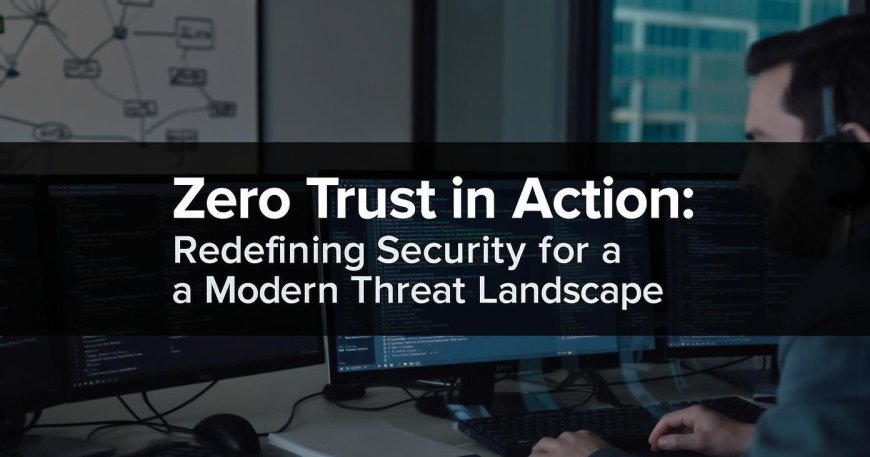Zero Trust in Action: Redefining Security for a Modern Threat Landscape
As organizations accelerate their digital transformation, the traditional approach to cybersecurity is no longer enough. Conventional security models that trust users inside the network perimeter have become obsolete in the face of sophisticated cyber threats, remote workforces, and cloud-native applications. Today, Zero trust goes beyond standard security, delivering a comprehensive, dynamic, and intelligent framework that aligns with the complexities of the modern threat landscape.

As organizations accelerate their digital transformation, the traditional approach to cybersecurity is no longer enough. Conventional security models that trust users inside the network perimeter have become obsolete in the face of sophisticated cyber threats, remote workforces, and cloud-native applications. Today, Zero trust goes beyondstandard security, delivering a comprehensive, dynamic, and intelligent framework that aligns with the complexities of the modern threat landscape.
Bizinfopro takes a deep dive into how the Zero Trust model transcends the limitations of legacy security strategies, equipping enterprises with the tools needed to thrive in a hyper-connected world.
The Downfall of Perimeter-Based Security
The perimeter-based approach to cybersecurity assumes that threats originate outside the corporate network and that users and devices inside can be trusted. This model worked when systems, applications, and users were all within a controlled office environment. However, the rise of remote work, cloud computing, mobile devices, and third-party integrations has shattered the conventional network perimeter.
Cyber attackers now exploit the gaps in traditional security systems using techniques like phishing, credential theft, and lateral movement. Once inside, they can move freely, often going undetected. This failure to prevent internal breaches highlights why Zero trust goes beyond standard security, challenging the assumption of implicit trust.
What Is Zero Trust?
At its core, Zero Trust is a security architecture based on the principle of never trust, always verify. Every access request, whether it comes from inside or outside the network, must be authenticated, authorized, and continuously validated.
Key principles of the Zero Trust model include:
Continuous verification of identities and devices
Least privilege access to reduce attack surfaces
Micro-segmentation of network zones
Contextual access control using analytics and threat intelligence
By enforcing these principles across every access point, Zero trust goes beyond standard security, ensuring no one is granted unchecked access to sensitive resources.
Business Drivers for Adopting Zero Trust
For modern enterprises, Zero Trust is more than a security upgradeit's a strategic necessity. It aligns with digital business models, enhances operational agility, and reduces organizational risk. Here's how Zero trust goes beyond standard security to deliver tangible business benefits:
Improved Risk Mitigation
Unlike traditional models that focus on blocking known threats at the perimeter, Zero Trust monitors and evaluates trust continuously. Every request is validated in real-time, which significantly reduces the risk of unauthorized access and data breaches.
Support for Cloud and Hybrid Environments
Zero Trust is designed for the dynamic nature of todays IT environments. It ensures consistent policies and controls across public, private, and hybrid clouds, safeguarding workloads and applications wherever they reside.
Remote Work Enablement
Remote work has become a permanent fixture for many organizations. Zero Trust provides secure, identity-based access for users working from any location or device, eliminating the need for a rigid, location-based perimeter.
Stronger Compliance Alignment
Many industries must comply with data protection regulations like GDPR, HIPAA, and CCPA. Zero Trust frameworks support regulatory requirements by enforcing strict access control, auditing, and breach prevention measures.
Key Components of the Zero Trust Model
Implementing a successful Zero Trust architecture involves integrating multiple technologies and processes. Each layer contributes to building a cohesive, secure ecosystem that protects against both internal and external threats.
Identity and Access Management (IAM)
IAM is the foundation of Zero Trust. It verifies user identities, manages permissions, and enforces policies such as multi-factor authentication (MFA), role-based access control (RBAC), and just-in-time access.
Endpoint Security and EDR
Zero Trust requires strong device-level security. Endpoint Detection and Response (EDR) tools monitor devices for anomalies, enforce compliance, and isolate compromised systems. Continuous endpoint verification is essential for preventing malware spread.
Network Segmentation and Micro-Perimeters
Rather than treating the network as one large trusted environment, Zero Trust advocates for micro-segmentation. Each segment is isolated and protected, limiting the ability of attackers to move laterally within the system.
Data Loss Prevention (DLP)
Controlling data movement is critical. DLP solutions monitor, detect, and block unauthorized data transfers. In the Zero Trust model, DLP enforces policies on sensitive files, even across cloud environments.
Security Analytics and Threat Intelligence
Zero Trust environments leverage AI-powered analytics and threat intelligence to monitor user behavior, detect anomalies, and respond to threats proactively. Real-time insights support dynamic access decisions.
Zero Trust vs Standard Security: A Comparison
To understand how Zero trust goes beyond standard security, its useful to compare both approaches:
Aspect Standard Security Zero Trust
Trust Model Trust once inside the perimeter Trust no one; verify continuously
Access Control Based on location (inside/outside) Based on identity, device, context
Perimeter Static network boundaries No perimeter; context-driven
Monitoring Reactive, event-driven Proactive, continuous validation
User Behavior Limited visibility Behavior-based analytics
This comparison reveals how Zero Trust is designed for a dynamic world, where identity and context define access not location.
Implementing Zero Trust: Best Practices
Transitioning to a Zero Trust model doesnt happen overnight. Organizations must follow a structured, strategic approach to ensure effectiveness and minimize disruption.
Start with Asset Discovery
Identify and categorize all assets, including users, applications, data, and devices. Understanding what youre protecting is the first step in building Zero Trust policies.
Classify and Prioritize Resources
Not all systems carry equal risk. Focus on high-value assets such as customer data, financial records, or intellectual property. Apply Zero Trust principles first to critical workloads.
Deploy Identity-Centric Controls
Enforce strong identity verification across all user access points. Use multi-factor authentication, conditional access, and continuous validation for all identities.
Segment Networks and Isolate Resources
Break down the network into smaller segments. Use firewalls, access control lists (ACLs), and software-defined perimeters to restrict lateral movement.
Adopt Least Privilege Principles
Grant users and systems only the permissions necessary to perform their duties. Regularly review and adjust access to ensure minimal exposure.
Integrate Security Analytics
Use machine learning and threat intelligence to monitor behavior and adapt policies dynamically. This enables quick detection of unusual or malicious activity.
Industry Trends: Growing Adoption of Zero Trust
Organizations across industries are rapidly adopting Zero Trust frameworks. Governments, healthcare providers, financial institutions, and large enterprises see Zero Trust as a vital part of their long-term cybersecurity strategy.
In the United States, the federal governments cybersecurity executive order mandates the adoption of Zero Trust principles across all agencies. Meanwhile, private sector leaders are investing in Zero Trust to future-proof their infrastructure against emerging threats like ransomware, insider attacks, and supply chain vulnerabilities.
Zero trust goes beyond standard security by shifting from passive defense to active, identity-based protection a necessity in today's threat landscape.
How Bizinfopro Helps Enterprises Embrace Zero Trust
At Bizinfopro, we empower organizations to modernize their cybersecurity infrastructure with a Zero Trust approach tailored to their specific needs. Our experts bring years of experience in designing, deploying, and managing Zero Trust environments for large and mid-size enterprises.
We offer:
Comprehensive Zero Trust assessments
IAM and EDR integration strategies
Micro-segmentation and DLP configuration
Cloud and hybrid security alignment
Ongoing monitoring, training, and support
With Bizinfopro, your security evolution is strategic, scalable, and future-ready.
Read Full Article : https://bizinfopro.com/webinars/zero-trust-goes-beyond-standard-security/
About Us : BizInfoPro is a modern business publication designed to inform, inspire, and empower decision-makers, entrepreneurs, and forward-thinking professionals. With a focus on practical insights and in?depth analysis, it explores the evolving landscape of global businesscovering emerging markets, industry innovations, strategic growth opportunities, and actionable content that supports smarter decision?making.
































